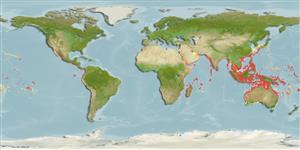Teleostei (teleosts) >
Carangiformes (Jacks) >
Carangidae (Jacks and pompanos) > Scomberoidinae
Etymology: Scomberoides: Greek, skombros = tunny or mackerel, 1623 + Greek, oides = similar to (Ref. 45335).
More on author: Cuvier.
Environment: milieu / climate zone / depth range / distribution range
Ecology
Marine; brackish; reef-associated; depth range 20 - 50 m (Ref. 28016). Tropical; 26°C - 29°C (Ref. 4959)
Indo-West Pacific: widespread throughout the Indian Ocean from Natal, South Africa northward and from Japan south to Australia and east to Fiji.
Length at first maturity / Size / Weight / Age
Maturity: Lm 26.0 range ? - ? cm
Max length : 60.0 cm TL male/unsexed; (Ref. 3197); common length : 40.0 cm TL male/unsexed; (Ref. 5450); max. published weight: 510.00 g (Ref. 40637)
Dorsal spines (total): 7 - 8; Dorsal soft rays (total): 19 - 21; Anal spines: 3; Anal soft rays: 18 - 20. Dorsally bluish, ventrally silver or white, with 5-8 vertically oblong or oval black spots5-8, the first 4-5 intersect the lateral line, dorsal fin lobe black outer half (Ref. 3197, 90105). Body strongly compressed, oblong and elliptical, dorsal and ventral profiles equally convex. In adults, upper jaw extends to posterior edge of pupil. Soft rays of posterior dorsal and anal fins consist of semi-detached finlets (Ref. 90102).
Adults are found near the surface in coastal waters (Ref. 30573), in small schools. They feed on fishes (Ref. 5213). Dorsal and anal fins may carry toxins (Ref. 12484). Generally marketed fresh, may be dried or salted (Ref. 5284).
Life cycle and mating behavior
Maturity | Reproduction | Spawning | Eggs | Fecundity | Larvae
Paxton, J.R., D.F. Hoese, G.R. Allen and J.E. Hanley, 1989. Pisces. Petromyzontidae to Carangidae. Zoological Catalogue of Australia, Vol. 7. Australian Government Publishing Service, Canberra, 665 p. (Ref. 7300)
IUCN Red List Status (Ref. 130435: Version 2024-1)
Human uses
Fisheries: minor commercial; gamefish: yes
Tools
Special reports
Download XML
Internet sources
Estimates based on models
Preferred temperature (Ref.
123201): 23.5 - 28.7, mean 27.8 °C (based on 381 cells).
Phylogenetic diversity index (Ref.
82804): PD
50 = 0.5625 [Uniqueness, from 0.5 = low to 2.0 = high].
Bayesian length-weight: a=0.00832 (0.00656 - 0.01055), b=2.89 (2.82 - 2.96), in cm total length, based on LWR estimates for this species (Ref.
93245).
Trophic level (Ref.
69278): 4.1 ±0.6 se; based on diet studies.
Generation time: 1.1 ( na - na) years. Estimated as median ln(3)/K based on 1
growth studies.
Resilience (Ref.
120179): High, minimum population doubling time less than 15 months (K=0.98).
Fishing Vulnerability (Ref.
59153): Low vulnerability (24 of 100).
Climate Vulnerability (Ref.
125649): High to very high vulnerability (71 of 100).
Nutrients (Ref.
124155): Calcium = 62.6 [35.3, 131.5] mg/100g; Iron = 1.04 [0.58, 1.82] mg/100g; Protein = 20.2 [19.2, 21.3] %; Omega3 = 0.165 [0.105, 0.281] g/100g; Selenium = 40.7 [22.1, 78.0] μg/100g; VitaminA = 44.8 [14.0, 145.5] μg/100g; Zinc = 1 [1, 1] mg/100g (wet weight);
